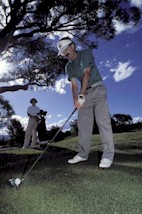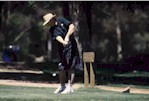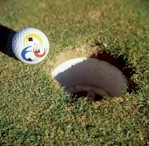 | ||
 |
||
|
| ||
 |
||||||
Golf Characteristics of the Sport Golf is a game of skill which can be played at a number of levels from the weekend hacker to the professional. Competitive golf is played at both amateur and professional levels. Golfers can turn professional either through an apprenticeship or by attending Player's School. Some professional golfers become attached to golf clubs and concentrate on providing golf tuition and running golf clubs. Others spend their time competing on the professional circuit. Training Recreational golfers practise their golf simply by playing. Professional golfers can spend up to eight hours a day on the golf course, practising specific skills, playing practice rounds or playing actual competitions. Even during a competition, many players will conduct a practice session at the end of the day's play. Most modern players also include strength training, aerobic conditioning and flexibility in their training schedule to strengthen the muscles involved in golf, improve endurance and minimise the risk of injury. Competition Competition golf is played in rounds of 18 holes. Tournaments are conducted as a single round on one day or as multi-day competitions of two or four rounds on consecutive days. A round typically takes between three to five hours to play, depending on the skill level of the player and the number of players on the course. The average golf course is seven kilometres from first to last hole, although a player may walk 10-20 kilometres in a game depending on the accuracy of the shots. In Australia, winter is the pro-am competition season and professional players typically travel on a circuit between club tournaments. During this season, a pro-golfer could play in ten tournaments, for a total of fifteen days of competition each month. The major international tournaments in Australia are played from January to March and from October to December, flanking the major season overseas between April to October. At the top level, golfers are almost continually on tour. Physical Characteristics Golf is primarily a game of skill therefore top golfers come in many shapes and sizes. In recent times, there is a tendency for top golfers to be fitter and leaner than ever before. Greg Norman is noted for the commitment he makes to staying fit and in shape. In a recent interview quoted in the Melbourne Age newspaper (29/8/01), he says, "This sport has changed. Players are stronger, fitter and their endurance is better. It's turned into a truly professional sport. I'm not saying it wasn't 20 or 30 years ago, but guys didn't include the nutrition and the physical fitness part that they do now." Theoretically, carrying excess skinfolds may make a player more susceptible to physical fatigue and thus more likely to suffer loss of skill and mental concentration. Being overweight may also make a golfer suffer greater heat intolerance in hot conditions. As golf is a repetitive spot, carrying excess body fat may also make a golfer more susceptible to injury. Common Nutrition Issues Training Nutrition Golfers of all levels require a diet which provides a wide variety of foods. The diet should focus on carbohydrate and be balanced with moderate amounts of protein and smaller amounts of fat. The following are key points:
Tournament Nutrition A top golfer must strive to maintain skills and concentration over three to five hours, perhaps for days on end. Once physical fatigue sets in, deterioration in skills can be expected. Both dehydration and low-blood sugar levels are possible during competition, and may impair golfing performance. Sweat losses may be considerable especially when tournaments are played in hot and windy environments. Although many golf courses provide drink stations for players, they may be at infrequent intervals and not allow sufficient opportunity for fluid replacement during a game. Since players will usually miss a meal while playing a round, they may be faced with no carbohydrate intake for five or six hours. Combined with exercise and nervous stress, this situation may cause a drop in blood-sugar levels in susceptible individuals affecting brain function and skill. When tournaments are played over several days the situation may be compounded. Chronic dehydration and an inadequate carbohydrate intake may cause fatigue, loss of weight and poor performance. The following tips can help to avoid some of these problems:
Life on the Circuit The professional golf circuit involves regular international travel. This can pose a number of challenges to meeting nutritional needs. Unusual foods, different standards of food hygiene, limited food availability and interference with usual routines can see athletes either gaining weight or failing to meet their nutritional requirements. The following tips may help:
Alcohol Intake A golf game traditionally finishes at the nineteenth hole - the clubroom bar. While there is no harm in having a couple of drinks, it is easy to slip into a pattern of drinking more than you realise or need. Alcohol is not good for fluid replacement as it acts as a diuretic and increases urinary fluid loss. Alcohol can also interfere with the recovery of the body's carbohydrate stores. If you plan to have a few drinks post-round, look after your rehydration and refueling needs first. Consume a few non-alcoholic drinks before consuming alcohol, or alternate alcoholic and non-alcoholic drinks. Keep a lid on the number of drinks you have and avoid alcohol 24 hours before competition. It is better to avoid alcohol intake during tournaments - after all you need all the skills and concentration that your brain can muster. Case Study Chip was a golfer with potential. He had risen effortlessly through the junior ranks and was ready to make his mark at a higher level. Things were going well for Chip until he experienced a major slump and bogies started replacing birdies. Chip was practising several hours a day, had started working with a new coach, had all the top equipment but couldn't get things together. His rounds started off OK but things started to deteriorate from about the tenth hole in all his rounds. Fortunately, for Chip, a sports dietitian came to speak at a club function one evening and Chip began to realise there were a few aspects of his match preparation which could be improved. Chip would grab a couple of pieces of toast on the way to the golf course. His mum always packed a drink but Chip would either forget to drink it or it would become warm and unappetising during the round. He would have a chocolate bar and 600ml of sports drink or a can of soft drink as he passed the club room and that was pretty much it until returning home - not much for 18-36 holes of golf! Chip realised he needed to get organised and start fuelling and hydrating his body and brain if he was to produce the sort of golf he was capable of. The first step was to get out of bed a little earlier to allow time for a decent breakfast. Chip didn't want to have to take large quantities of food onto the golf course but found he could compensate by having more to eat at breakfast. Chip's favourite breakfast was cereal with low fat milk and banana on top, 3 slices of toast and a fruit smoothie. This provided a good amount of carbohydrate without being too filling. Chip also bought an insulated 1 litre fluid container. He filled this up with sports drink in the morning then refilled it with water on the course once he ran out. Chip made a habit of grabbing a quick drink after each tee shot and just before reaching the putting green. This timing pattern helped remind Chip to drink regularly. Chip also got into the habit of stocking his buggy with a couple of cereal bars and a couple of pieces of fruit. He would munch on these while waiting to tee off and made himself a rule that he would not play more than 9 holes without having something to eat. These few simple changes meant Chip was now better hydrated and able to maintain good blood glucose levels. This helped Chip maintain concentration and minimise fatigue. It wasn't long before the birdies came back!
You will find more information about golf at the
Australian Institute of Sport on the
|
| |||||
|
The Department of Sports Nutrition is a program of the
Australian Institute of Sport General enquires can be emailed to: aisnutrition@ausport.gov.au Copyright
© Australian Sports Commission
| ||||||





